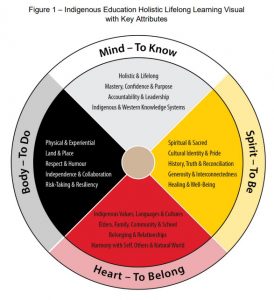The Calgary Education board published a guide in 2022 called the Indigenous Education Holistic Lifelong Learning Framework with the extensive support of Elders and Knowledge Keepers of the Piikani, Kainai, Metis, Tsuut’ina, Stoney Nakoda, Kahkewistahaw, Muskoday and Siksika Nations.
The guide clearly states it is “not a how-to guide for Indigenous Education or a recipe for closing gaps” and instead is a foundation where we can “meaningfully position and deepen our individual and collective knowledge, decision, and actions to meet the holistic needs of all students.”
This guide is interesting to my research because the approach, though from a very high-level school board, is meant to adapt to include Indigenous students, but does not single them out. Instead, they use holism, and Indigenous worldview, to attend to all students’ spiritual, emotional, physical, and intellectual needs. They use the medicine wheel to visualize the framework.

Hello Jennifer, I use the medicine wheel for many teachings when I work with my Indigenous colleagues. I have used it for nature journaling with students. We focus on the 4 directions, the 4 elements, lifecycles and other holistic teachings. I appreciate this CBE diagram as it has the additional words around the circle Mind -To Know, Spirit- To Be, Heart-To Belong, and Body – To Do. I also appreciate how you say this is used to support all students to think how Indigenous Ways are interconnected to all that we do.
What a lovely comment. Thank you, Paula!